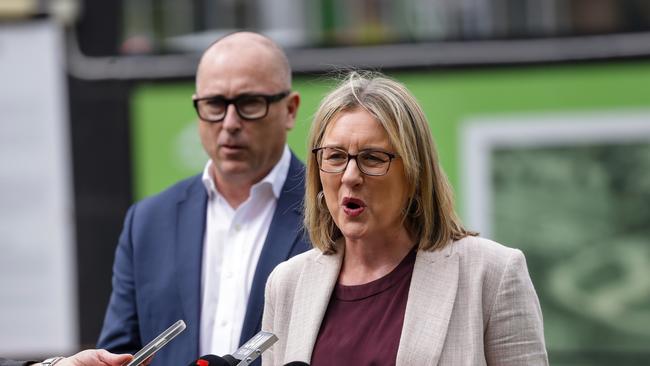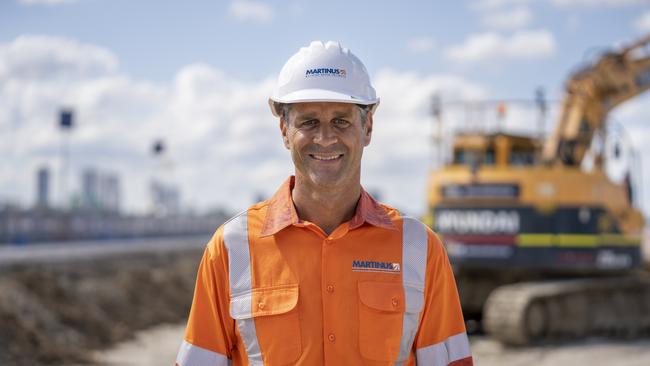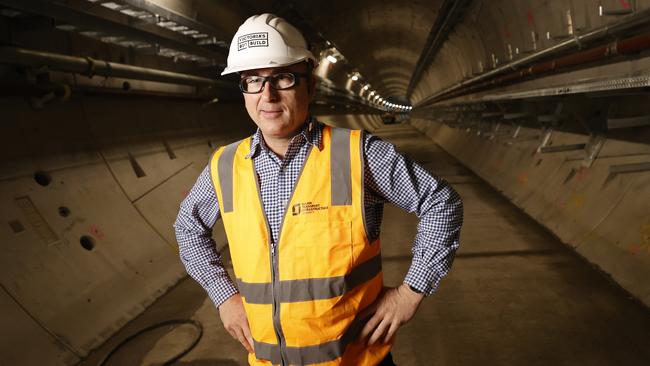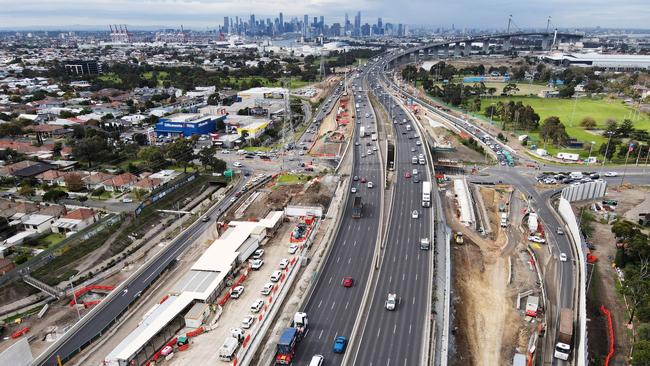Big Build boss Corey Hannett resigns from top transport job
He was the man who kept the $90bn projects sector running during lockdown. Now, Corey Hannett has spoken candidly of the increasing pressures he faced.
Victoria
Don't miss out on the headlines from Victoria. Followed categories will be added to My News.
Multibillion-dollar mega projects should be structured to ensure Australian companies reap the benefits of our once-in-a-lifetime public sector building blitz, infrastructure chiefs say.
In an exclusive interview, outgoing Big Build boss Corey Hannett said the legacy of the state’s boom should not just be road or rail assets but the skills and industry capabilities that flow through to future generations.
Predicting that the pace of infrastructure construction was unlikely to slow for decades given the pipeline of projects in place, Mr Hannett said it was important to ensure there are “more companies succeeding and thriving in the boom”.
“To do that, you’ve got to give them opportunity,” he said. “And to do that, you’ve actually got to set up in a way that they are given the opportunity.”

Since he began in the role in 2014, mega-project contracts have been altered to effectively split jobs into smaller packages, meaning mid-tier Australian companies can compete.
Examples include the $10bn Melbourne Airport Rail Link and the $16bn North East Link, while alliance agreements on level crossing removals have also ensured global giants don’t soak up all the work.
Mr Hannett said the move to ban international Tier 1 companies from doing joint ventures together on North East Link was met with howls of protest but has ensured a greater breadth of contractors involved.
“You need to share the work around,” he said. “You need your infrastructure delivery to thrive and survive and develop companies and people so the future is prosperous.”

Australian Owned Contractors chief executive, Brent Crockford, said more procurement incentives should be locked into the Albanese government’s Future Made in Australia Plan.
“It means more Aussie jobs working in Aussie companies, building Aussie infrastructure,” Mr Crockford said. “More money stays in Australia, is reinvested in local businesses, and we build sovereign capability in our local contracting industry.”
Australian-owned rail infrastructure company Martinus has grown from 10 employees in 2013 to more than 1500 in 2023. Chief executive Treaven Martinus said being able to remain local but compete on bigger jobs meant more support for other businesses.
“We’ve got a proud stat that 84 per cent of our spend is with Australian small and medium enterprises, so we’re partnering with industry to grow capability and that’s what breaking these projects up enables,” he said.
Victoria’s Big Build boss calls time
Every Sunday during Victoria’s strict Covid-19 lockdowns, Big Build boss Corey Hannett would hop in his car and drive to a level crossing removal site.
He would arrive unannounced and wander around the project area to check that workers were following Covid-safe rules.
Major projects had been dubbed essential work under tough guidelines, but Hannett knew that lax safety would see the $90bn sector shut down completely.
The ramifications of that would have been billions of dollars of extra costs and delays but more importantly, thousands more people sent home and without work.
“The thing that I felt the pressure of was the enormity of if the workforce wasn’t working,” he said.
“Lord knows what it would have done to the program.
“I’m very appreciative of the workforce, because … I think all everybody had a crack at trying to do the right thing.
“It just gave me a level of comfort; sometimes you might have a worker that’s had a smoke and forgot to put his mask back on, but all in all it was clear to me that the bulk of most people were doing the right thing.”

The pace of infrastructure in Victoria – compounded by the pandemic’s extra pressures – has been unrelenting since Hannett took the role of Director-General at the Major Transport Infrastructure Authority in 2014.
But he’s not complaining.
While he had previously led the Regional Rail Link Authority, Hannett became indispensable to the Andrews Government over its nine years in office.
He’s also well regarded within the construction industry for his leadership on the $90bn public sector “Big Build”.
This includes introducing new contract measures to allow for more Australian companies to compete with global giants.
Mega projects were effectively split into bite-sized chunks – for example on Melbourne Airport Rail Link seven packages were established for a $10bn build.
On the $16bn North East Link, the biggest players in the market – all foreign-owned – were banned from setting up joint ventures together that would crowd out the market.
“I went to a conference, (Treasurer) Tim Pallas and I said ‘you can’t team up together’ and they went apeshit, said ‘the sky’s going to fall down, it’s going to be terrible’.
“It wasn’t terrible at all.”
Hannett said the global expertise and big hitters were a valuable part of the infrastructure puzzle but it meant others working with them were “learning”.
“For the next job you don’t have to have the same experts, you have got other experts as well because they have been on the job.”

Several mega projects have blown budgets while Mr Hannett has been in charge, including the West Gate Tunnel by $4.1bn and the Metro Tunnel by more than $3bn.
But the MTIA director-general said a lot of time sometimes passed between when a business case is created and designs are finalised, meaning costs sometimes fluctuate significantly.
He pointed to the North East Link, which was initially costed at $10bn and later revised to $15.8bn – and which is set to rise again, where community feedback led to a government decision to lengthen the tunnel by 2km to reduce impacts.
Mr Hannett was also integral to the decision to create sky rail along the Pakenham and Cranbourne lines, which was hugely controversial in the government’s first term.
“We were under the pump bad, and we just had to persevere,” he said.
Dozens of extra level crossing removals have since been done using elevated tracks, and Hannett said the early lessons of the state’s infrastructure blitz was the imperative to communicate effectively to the community.
“Communicate why we’re doing what we’re doing, and how can we do it, and what the benefit is … we can’t communicate enough,” he said.
Mr Hannett said he had not decided what to do next in his career, which has spanned the private and public sector construction industry for three decades, which makes him “a bit nervous”.
But spending more time at home with his wife and youngest son Harry, who is autistic, will be a given.
“My older boys have grown up, one is 24 and one is 22 … but my whole experience of Harry since he could talk, I’ve been in this job,” he said.
“That’s fine, but it’s long hours and 24/7.
“Mind you though, I’m not for a minute saying I wouldn’t take a difficult job (next). But I’ve been in these two jobs for 14-and-a-half years and how much longer do you do that for? One year, two years?
“There comes a point in your life where you want to experience other things.”





